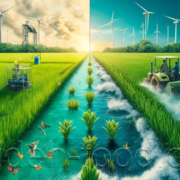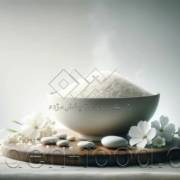New methods of rice cultivation
In this article, we will explore and explain modern rice cultivation methods, including soilless cultivation, horizontal cultivation, and combined cultivation. We will attempt to comprehensively examine the advantages and disadvantages of each method and, considering the environmental and economic conditions of each region, focus on selecting the best method for rice cultivation. Agriculture, as one of the oldest human activities, has always played a significant role in human history. The importance of producing food products, especially products like rice which are among the most important food sources in the world, is undoubtedly very high. However, over time, there is a felt need for more efficient and sustainable methods in the cultivation and production of these products.
Modern rice cultivation methods, as a response to challenges such as reducing water resources, increasing productivity, preserving the environment, and securing food safety, have emerged. These methods not only help improve cultivation performance and reduce production costs but also have many positive effects on the environment and improve the economic conditions of farmers.
Our effort in this article is to provide comprehensive and complete information to help farmers and those interested in agriculture to choose better ways to cultivate rice and to act for more successful and sustainable production in this field.
Modern Methods of Rice Cultivation Soilless Direct Rice Cultivation
One of the innovative and interesting methods of rice cultivation is direct soilless cultivation, which is presented as one of the aquaculture farming methods. In this method, rice seeds are directly planted on the water surface. This method, which is relatively new in agriculture, utilizes advanced technologies such as hydroponics.
Performance and Benefits
One of the prominent benefits of direct soilless cultivation is water conservation. In this method, rice is grown without soil and is exposed to water, which leads to reduced water consumption and higher productivity in using this valuable resource. Additionally, this method leads to a reduction in the need for fertilizers and chemical pesticides, ultimately helping to preserve the environment and reduce pollution in water and soil.
Disadvantages and Challenges
Although direct soilless cultivation has many benefits, it also faces some challenges. One of the most significant challenges of this method is water management and water quality control. Since the rice is grown in water, if the water quality is poor, it could harm the performance and quality of the crop. Also, the need for advanced equipment and technologies such as hydroponic systems and precise management of nutrient solutions is considered a disadvantage of this method.
Usage in Different Regions
Direct soilless cultivation, due to its water-saving benefits and the possibility of use in areas with water scarcity, is considered an appropriate solution for rice production in dry and water-scarce areas. However, the success of this method depends on the climatic conditions and available technologies of each region, and it may be less effective in some areas. Direct soilless cultivation, as one of the modern methods of rice cultivation, comes with benefits such as water conservation, reduced use of fertilizers and chemical pesticides, and environmental preservation. However, it still faces challenges such as water management and quality. The use of this method in areas with water scarcity is promoted as an efficient solution for rice production.
Horizontal Rice Cultivation
Horizontal cultivation is one of the innovative and effective methods in rice cultivation that, due to its unique nature, brings significant improvement in performance and productivity. In this method, instead of planting in soil, rice is planted horizontally on the ground surface. This method is especially used in areas facing spatial limitations.
Performance and Benefits
Horizontal cultivation has many benefits, including higher land use efficiency, reduced waste and product loss, and increased farm yield and efficiency. With horizontal planting of rice, there is the possibility to improve the distribution of light, air, and water in the field, which leads to increased nutrient absorption by the plants and, consequently, increased product yield.
Disadvantages and Challenges
Although horizontal cultivation has many benefits, it also faces some challenges. One of the main challenges of this method is the need for land space to perform cultivation. In some areas where land space is limited, implementing this method may be problematic. Additionally, managing water resources and controlling water quality are other challenges that need serious consideration.
Usage in Different Regions
Due to the benefits it provides, horizontal cultivation can be used in various geographical areas with different conditions. This method is particularly suitable for regions with space limitations or those needing high efficiency from land use. Also, considering its positive effects on water resource distribution and agricultural productivity, it can be proposed as an appropriate solution for rice production in areas with water scarcity. Horizontal cultivation, as one of the modern methods of rice cultivation, with features such as higher efficiency from land space, waste reduction, and increased product performance, is introduced as an effective method for rice production in areas with spatial limitations and water scarcity issues. However, it still faces challenges such as water resource management and water quality control, requiring suitable solutions and precise management.
Combined Cultivation
Combined cultivation is one of the widely used and effective methods in rice cultivation that leads to improved performance and reduced risks associated with rice cultivation by integrating different plant species in a single farm. In this method, instead of cultivating one type of plant, two or more types are planted simultaneously in a farm, which leads to improved plant nutrition and increased product performance.
Performance and Benefits
Combined cultivation has many benefits, among the most important of which are increased yield and farm efficiency, reduced risks related to diseases and pests, and improved soil structure. Planting two or more types of plants simultaneously allows for mutual feeding of plants, optimal use of water and nutrients, and reduced dependency on chemical pesticides, which generally enhances farm performance and output.
Disadvantages and Challenges
Although combined cultivation has many advantages, it also faces some challenges. One of the most significant challenges in this method is the need for precise and intelligent management of water and nutrients for each type of plant. Also, choosing plants that have good mutual nutrition and can coexist with one another is another important challenge that needs attention.
Use in Different Regions
Due to the benefits it offers, combined cultivation can be used in different geographic areas with varying conditions. This method is particularly suitable in areas that face various problems such as water shortage, diseases, and pests, and soil defects. With the right selection of plants and precise resource management, this method can yield greater efficiency in rice cultivation. Combined cultivation, as one of the modern methods of rice cultivation, with features like increased farm yield and efficiency, reduced risks related to diseases and pests, and improved soil structure, is introduced as an effective method for rice production. However, it still faces challenges such as resource management and appropriate plant selection, requiring suitable solutions and precise management.
Advantages and Disadvantages of Modern Rice Cultivation Methods
Modern cultivations always aim to improve performance, reduce costs, and preserve the environment. In this section, we explore the advantages and disadvantages of various modern cultivation methods including soilless cultivation, horizontal cultivation, and combined cultivation.
Advantages
- Increased Productivity: Soilless and horizontal cultivation methods are associated with higher efficiency in the use of water and soil resources, which leads to increased production and reduced food waste.
- Reduced Use of Chemical Pesticides: Using fewer chemical pesticides in modern cultivations reduces their harmful effects on the environment and human health.
- Reduced Environmental Pollution: With reduced need for fertilizers and chemical pesticides, modern cultivations can help decrease pollution in air, water, and soil.
- Suitable for Dry and Water-Scarce Areas: Modern cultivation methods, like soilless cultivation, can utilize limited water resources in the most optimal way and be successful in water-scarce regions.
Disadvantages
- Need for Advanced Technology: Some modern cultivation methods require the use of advanced technologies such as hydroponics and specific irrigation systems, which may create high initial costs for farmers.
- Management Challenges: Managing water, fertilizer, and chemical pesticides in modern cultivations requires precision and sufficient knowledge, which may pose challenges for some farmers.
- Acceptance and Change in Thinking Patterns: Transitioning to modern cultivation methods requires acceptance and a change in thinking patterns in society and the agricultural environment, which may be time-consuming.
- Technical Problems and Limited Capabilities: Some farmers may lack the technical abilities and knowledge required for modern cultivation methods, which can be a disadvantage of these methods.
Nevertheless, with proper implementation and appropriate optimization, modern cultivations can bring about significant improvements in agricultural performance and productivity as well as environmental preservation.
Be sure to read the article “The Stages of Planting and Producing Iranian Rice in Simple Language”.
Questions and Answers about Modern Rice Cultivation Methods
- Does soilless rice cultivation reduce the quality of the product? If executed correctly and using appropriate technologies, soilless rice cultivation can enhance product quality. However, precise management and quality control of water and nutrients are essential to prevent quality deterioration.
- Is horizontal cultivation suitable for all regions? Horizontal cultivation can be efficient in many regions, but climatic conditions, soil, and other environmental factors must be considered. In some regions, this method may be less effective due to specific conditions.
- Does combined cultivation reduce environmental pollution? Yes, combined cultivation can reduce environmental pollution because with a diversity of plants in the field, the need for fertilizers and chemical pesticides decreases, thus reducing negative impacts on the environment.
- Are modern rice cultivation methods suitable for increasing rice production in developing countries? Certainly, modern rice cultivation methods can be beneficial in developing countries, especially in managing water resources and enhancing agricultural productivity, which are of great importance.
- Can modern rice cultivation help reduce global hunger? Yes, using modern rice cultivation methods can lead to increased production and improved food security globally. With increased yield and reduced product waste, these methods can contribute to reducing global hunger.
Summary
This article explored modern rice cultivation methods, including soilless cultivation, horizontal cultivation, and combined cultivation. Each of these methods has its own advantages and disadvantages that must be considered in light of the environmental and economic conditions of each region. With the correct implementation of these methods, it is possible to improve the performance and productivity of rice cultivation, thereby helping to reduce hunger and increase global food security.






Leave a Reply
Want to join the discussion?Feel free to contribute!